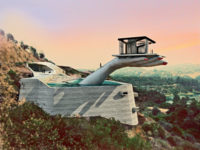Greek architect Andreas Angelidakis has a penchant for designing exhibitions that are all-encompassing experiences. For the show The System of Objects, on view at the Deste Foundation in Athens through November 30, the Sci-ARC and Columbia alum curated a hybrid art and design exhibition from the vast holdings of mega-collector Dakis Joannou and then designed a maze-like warren of interior spaces for the work to inhabit. “There is a sense of a theme park,” he said just after the opening in May. “People tell me that they get lost, both literally—they don’t know where to go—and also in time, as if in a dream.”
This week, the architect’s approach is on display at a smaller scale at the Frieze Art Fair in London, which runs through October 20. Curator Nicola Lees, who organized this year’s Frieze Projects (a series of exhibitions and events that runs in tandem with the commercial side of Frieze), invited Angelidakis to design a stage for performances taking place during the fair. He devised a 3,000 square-foot riff on a black box theater with a playful twist—its walls are modules made of lightweight foam that can be reconfigured to create a custom interior for each performance in the series. It has already become a bedroom for French artist Lili Reynaud-Dewar, and this weekend it will convert into a boardroom for a committee of children—all around age 12—convened by Finnish satirist of office culture Pilvi Takala, among other performances (view a full schedule here).
The messy, continually shifting space contrasts with the brightly lit and comparatively orderly aisles of Frieze’s Carmody Groarke-designed pavilion in Regent’s Park. Record recently spoke with Angelidakis about designing for this unusual context as well as some of his forthcoming work.
What appealed to you about designing a space for ancillary programming at an art fair?
I was interested in how to design a space that would exist for just four days, but the art fair format is challenging. The visitor to a fair is quite different than a biennial or a museum exhibition visitor. With a biennial you have their full attention, and you can use the space to calibrate their experience. At a fair, you have all of these galleries exhibiting stuff, but with a merchandise mentality. Visitors arrive in your space already overwhelmed by visuals, so you have to provide an immediate experience. There is no time for preparing them, there are no introductory spaces.
I was interested trying to do something refreshing. There is a black floor and black ceiling, and everything looks precarious and in flux.
Why did you design the space with these lightweight modular walls?
We needed something that could be reconfigured quickly, so we came up with the idea of foam walls and a general layout that feels undesigned and the result of actions rather than planning, even though we worked extensively on where and how each work would be placed.
Also, Nicola explained her idea of the whole Frieze Projects exhibition, which is somewhat inspired by Lord of the Flies. There’s a childlike meanness to a lot of the work. So we made these enormous building blocks. It’s a little bit like a kid’s idea of an art fair. The big walls are quite monolithic, but because they’re styrofoam, you can move them around or lean one wall against the other as if it had fallen down.
It’s a space where things look as if they are the result of something, not carefully planned, as if someone was in there doing something and then left abruptly. You know, when a child’s toys are left behind on a carpet, you can see that the kid was up to something.
In one sense, it’s playful, but in another, it evokes the idea of ruins.
The Frieze project will only last for a few days. Do you have any longer term projects in the works?
I have a book coming out next month that documents three years of workshops examining the Stockholm suburb of Väsby. In it, we’re trying to combine urban planning with a business sense, using theory as a way to brand development, which is kind of dirty. Then, Greece has the presidency of the EU next year—funnily enough—so I’m doing an installation for the building that will house the Council of the European Union. That will be my big Greek pride moment.






